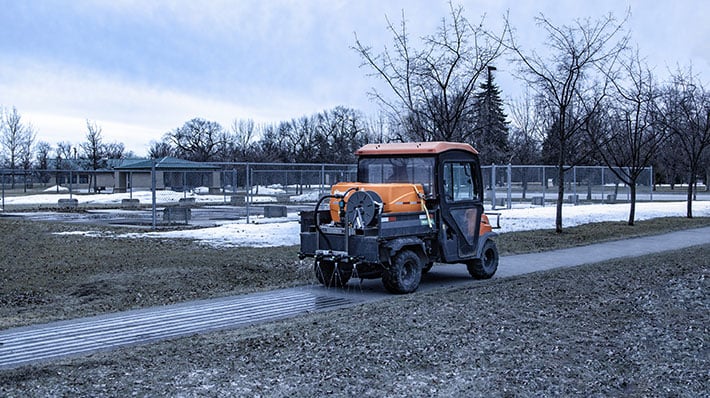
We've really got to start having a discussion about how are we going to inspire the change to using liquid brine. In this post, Phill Sexton with WIT Advisers will go over what the barriers are of switching to liquid brine for de-icing in snow and ice management.
Changing Our Mindset About Liquids
So first, who is it we're trying to convince that this is a no-brainer?
It first starts with us. Do I really believe that this can work? Do I really believe that the same thing that's coming out of that nozzle, is the same thing that was being broadcast by a salt spreader.
Number two is "who are we doing this for?" and that's our customers. Don't we need to convince them before we're enabled to practice a different way?
Next, we have to convince the property owners and property managers that it's the same thing, just in a different form. That's important to state clearly and simply. In order for us to convince ourselves and our customers, let's address what the barriers are.
The barriers are in 2 primary categories.
- Liability
- Perception
- Slip & Falls
- Vehicular accidents
We've been able to ascertain from even the third party research is in many cases, properties that are utilizing a liquid methodology while preventing the bond (that's the most important piece. The liquid is the most efficient tool to prevent the bond) we've seen results on sites that do it versus sites that don't do it a...
|
50% REDUCTION OF SLIP & FALL INCIDENTS
|
Our Customers Perception
That may not be enough to convince people so the other thing that we have to think about is perception. Perception in this case is seeing the salt; it's a perceived level of service expectation that most properties have. "If I don't see the salt, that means there's a greater chance that there's going to be a slippery condition." Which is absolutely false. However, perception is reality in this case.
We're going to need to address to the industry at large how we change that perception so that not seeing it, doesn't necessarily mean that it's not working. There are a couple ideas to think about. I've seen tracking dye being used. I don't always recommend that though because that can cause some other perceived issues as far as “Is it going to stain? Is it dangerous? If it's blue or red does it mean there's some other chemical in it?”
The real trick comes into communication. Sometimes communication can be done with signage. Sometimes it can be done with a broad stakeholder engagement to say, "It's been done this way in the past now we're going to do it this way". Sometimes it's just plain old communication to say, "Understand that we're testing this new method, and here's the results that we're expecting to achieve. We'll keep you up to date".
I hope this article has helped you navigate the barriers you may face when switching to liquid brine. To shop our variety of liquid brine sprayers, visit our website. If you have any questions, feel free to comment below and we'll get back to you.
Interested in more FREE TRAINING? Here are links to the complete course:
Why is Using Liquid Brine Important? [1 of 10]
Environmental Benefits of Liquid Brine [2 of 10]
Economical Benefits of Liquid Brine [3 of 10]
Level of Service Benefits of Liquid Brine [4 of 10]
Rock Salt vs Liquid Brine [5 of 10]
Preventing the Bond of Snow & Ice with Liquid Brine [6 of 10]
What are the Barriers of Switching to Liquid Brine Deicing? [7 of 10]
Why Aren't More Clients Asking for a Liquids Approach? [8 of 10]
How do we Make the Change to Liquids? [9 of 10]
Liquid Brine Spraying Techniques [10 of 10]



